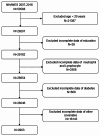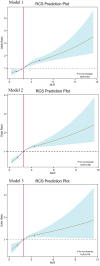The association between the neutrophil-to-lymphocyte ratio and type 2 diabetes mellitus: a cross-sectional study
- PMID: 38982402
- PMCID: PMC11232124
- DOI: 10.1186/s12902-024-01637-x
The association between the neutrophil-to-lymphocyte ratio and type 2 diabetes mellitus: a cross-sectional study
Abstract
Background: Type 2 diabetes mellitus (T2DM) is a prevalent chronic disease often accompanied by low-grade inflammation. Recently, the neutrophil-to-lymphocyte ratio (NLR) has garnered researchers' interest as an emerging inflammation biomarker. This study aimed to comprehensively explore the relationship between NLR and T2DM using the National Health and Nutrition Examination Survey (NHANES) database.
Method: We employed a cross-sectional study design to analyze data from five NHANES cycles from 2007 to 2016, excluding individuals with incomplete data. This study utilized a weighted logistic regression model, subgroup analyses, and restricted cubic spline (RCS) analysis to assess the potential relationship between NLR and T2DM.
Results: A total of 9903 participants were eligible for the analysis, of which 1280 were diagnosed with T2DM. The T2DM group exhibited significantly higher NLR levels than the non-T2DM group. After adjusting for potential confounders, elevated NLR levels were associated with an increased risk of developing T2DM, indicated by an odds ratio (OR) of 1.14, 95% CI: (1.05,1.24), P = 0.003. The results of the subgroup analyses revealed a significant interaction effect between NLR and T2DM concerning race and hypertension (P for interaction < 0.05). In contrast, no significant interactions were found for age, sex, education level, body mass index (BMI), smoking status, recreational activities, and alcohol drinker (P for interaction > 0.05). RCS analysis showed a significant non-linear relationship between NLR and T2DM, with an inflection point at 2.27 (all P for non-linearity < 0.05).
Conclusion: Our study indicates that an elevated neutrophil-to-lymphocyte ratio is associated with a higher risk of T2DM.
Keywords: Cross-sectional study; Inflammation; Neutrophil-to-lymphocyte ratio; Type 2 diabetes mellitus.
© 2024. The Author(s).
Conflict of interest statement
The authors declare no competing interests.
Figures


Similar articles
-
Association between neutrophil-to-lymphocyte ratio and diabetic kidney disease in type 2 diabetes mellitus patients: a cross-sectional study.Front Endocrinol (Lausanne). 2024 Jan 4;14:1285509. doi: 10.3389/fendo.2023.1285509. eCollection 2023. Front Endocrinol (Lausanne). 2024. PMID: 38239986 Free PMC article.
-
Association between the neutrophil-to-lymphocyte ratio and cancer in adults from NHANES 2005-2018: a cross-sectional study.Sci Rep. 2024 Oct 10;14(1):23678. doi: 10.1038/s41598-024-75252-0. Sci Rep. 2024. PMID: 39390050 Free PMC article.
-
The neutrophil-lymphocyte ratio as a risk factor for all-cause and cardiovascular mortality among individuals with diabetes: evidence from the NHANES 2003-2016.Cardiovasc Diabetol. 2023 Sep 29;22(1):267. doi: 10.1186/s12933-023-01998-y. Cardiovasc Diabetol. 2023. PMID: 37775767 Free PMC article.
-
The Relationship between Neutrophil-to-Lymphocyte Ratio and Intracerebral Hemorrhage in Type 2 Diabetes Mellitus.J Stroke Cerebrovasc Dis. 2017 May;26(5):930-937. doi: 10.1016/j.jstrokecerebrovasdis.2016.10.041. Epub 2016 Nov 28. J Stroke Cerebrovasc Dis. 2017. PMID: 27908556
-
The Association between Neutrophil-to-Lymphocyte Ratio and Glycemic Control in Type 2 Diabetes Mellitus: A Systematic Review and Meta-Analysis.J Diabetes Res. 2023 Jun 3;2023:3117396. doi: 10.1155/2023/3117396. eCollection 2023. J Diabetes Res. 2023. PMID: 37305430 Free PMC article. Review.
Cited by
-
The relationship between system inflammation response index and coronary heart disease: a cross-sectional study (NHANES 2007-2016).Front Cardiovasc Med. 2024 Aug 12;11:1439913. doi: 10.3389/fcvm.2024.1439913. eCollection 2024. Front Cardiovasc Med. 2024. PMID: 39188319 Free PMC article.
-
Association between depression and diabetes among American adults using NHANES data from 2005 to 2020.Sci Rep. 2024 Nov 12;14(1):27735. doi: 10.1038/s41598-024-78345-y. Sci Rep. 2024. PMID: 39532999 Free PMC article.
References
-
- Heald AH, Stedman M, Davies M, Livingston M, Alshames R, Lunt M, Rayman G, Gadsby R. Estimating life years lost to diabetes: outcomes from analysis of National Diabetes Audit and Office of National Statistics data. Cardiovasc Endocrinol Metab. 2020;9(4):183–5. doi: 10.1097/XCE.0000000000000210. - DOI - PMC - PubMed
-
- Sun H, Saeedi P, Karuranga S, Pinkepank M, Ogurtsova K, Duncan BB, Stein C, Basit A, Chan JCN, Mbanya JC, et al. IDF Diabetes Atlas: Global, regional and country-level diabetes prevalence estimates for 2021 and projections for 2045. Diabetes Res Clin Pract. 2022;183:109119. doi: 10.1016/j.diabres.2021.109119. - DOI - PMC - PubMed
MeSH terms
Substances
LinkOut - more resources
Full Text Sources
Medical

